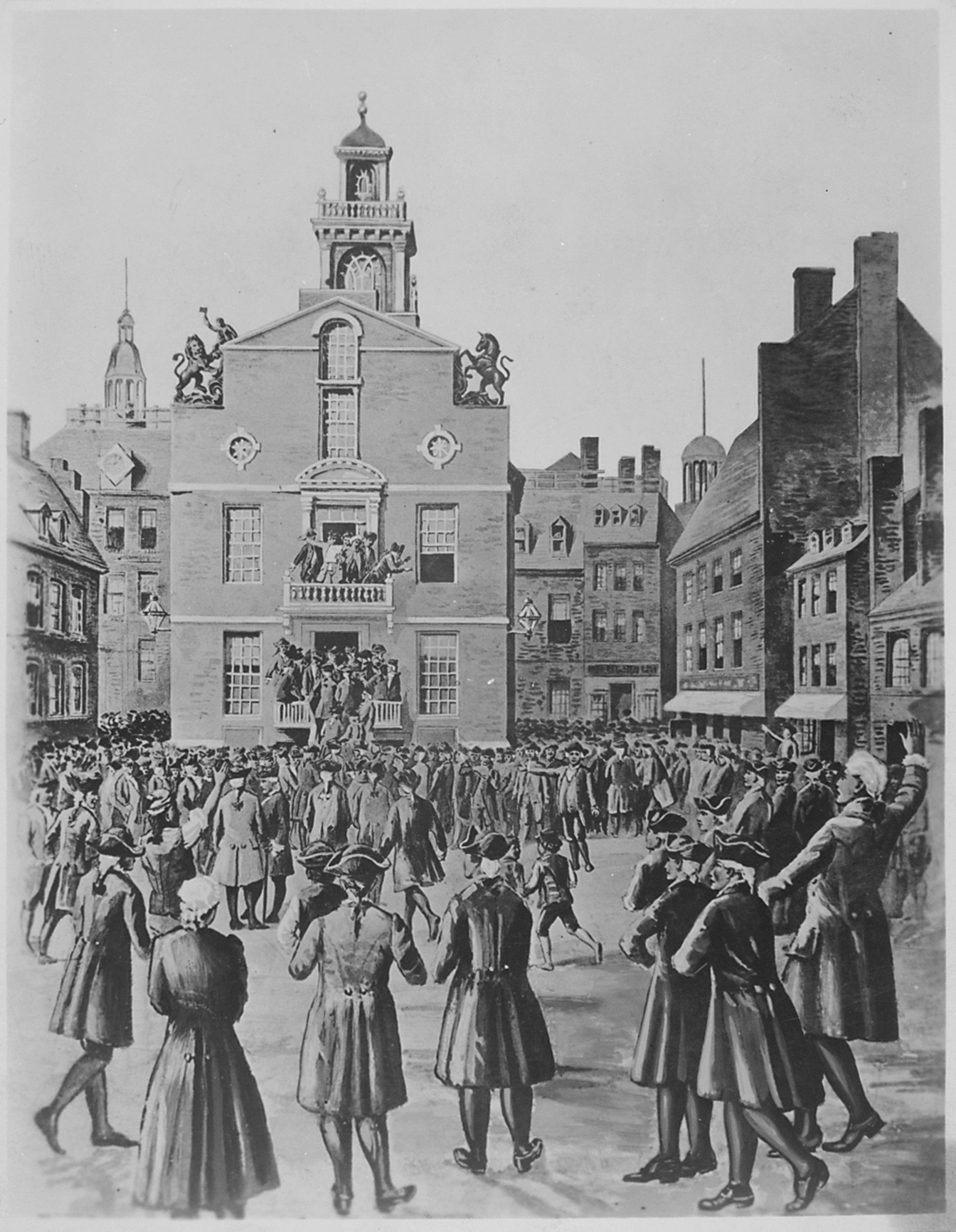Prequel to Independence
Finding a Sequence
All documents and text associated with this activity are printed below, followed by a worksheet for student responses.Introduction
A long series of outrages and abuses over time would drive the English citizens living in the colony of Massachusetts to seek self-government, believing that the united colonies were and should be free and independent states. Some of the events, which we might call the Prequel to Independence, represent key moments in the many years leading up to the creation of the United States of America.In this activity, you will place a set of documents and images in chronological order. If you get stumped, use the "Show Hints" button.
Name:
Class:
Class:
Worksheet
Prequel to Independence
Finding a Sequence
Examine the documents in this activity. Put the corresponding document numbers in order using the list below. Write your conclusion response in the space provided.1
2
3
4
5
6
7
8
9
10
Hints for this Activity
- Remember Crispus Attucks died here.
- We would become a nation of coffee drinkers.
- An equestrian event that warned the locals.
- He said, "if they mean war, let it begin here."
- "Don't fire until you see the whites of their eyes!"
- Siege of Boston April 19, 1775- March 17, 1776.
- Daring treasonous resolution is presented.
- Congress appointed a committee of 5.
- We did it!
- ...and we told everybody about it across the land!
1
Activity Element
Deposition of Captain John Parker Concerning the Battle at Lexington
Page 1
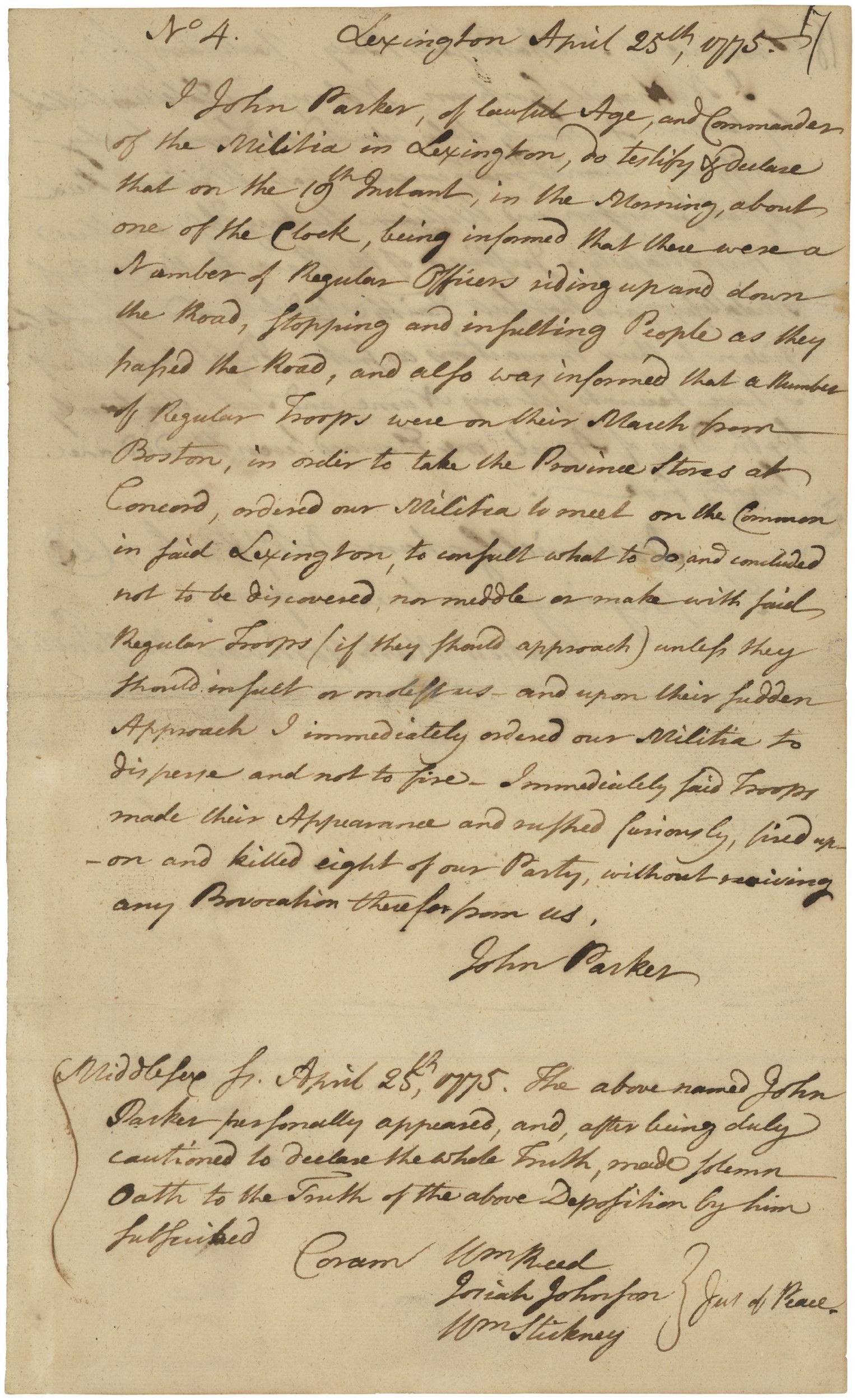
2
Activity Element
The Declaration of Independence
Page 1
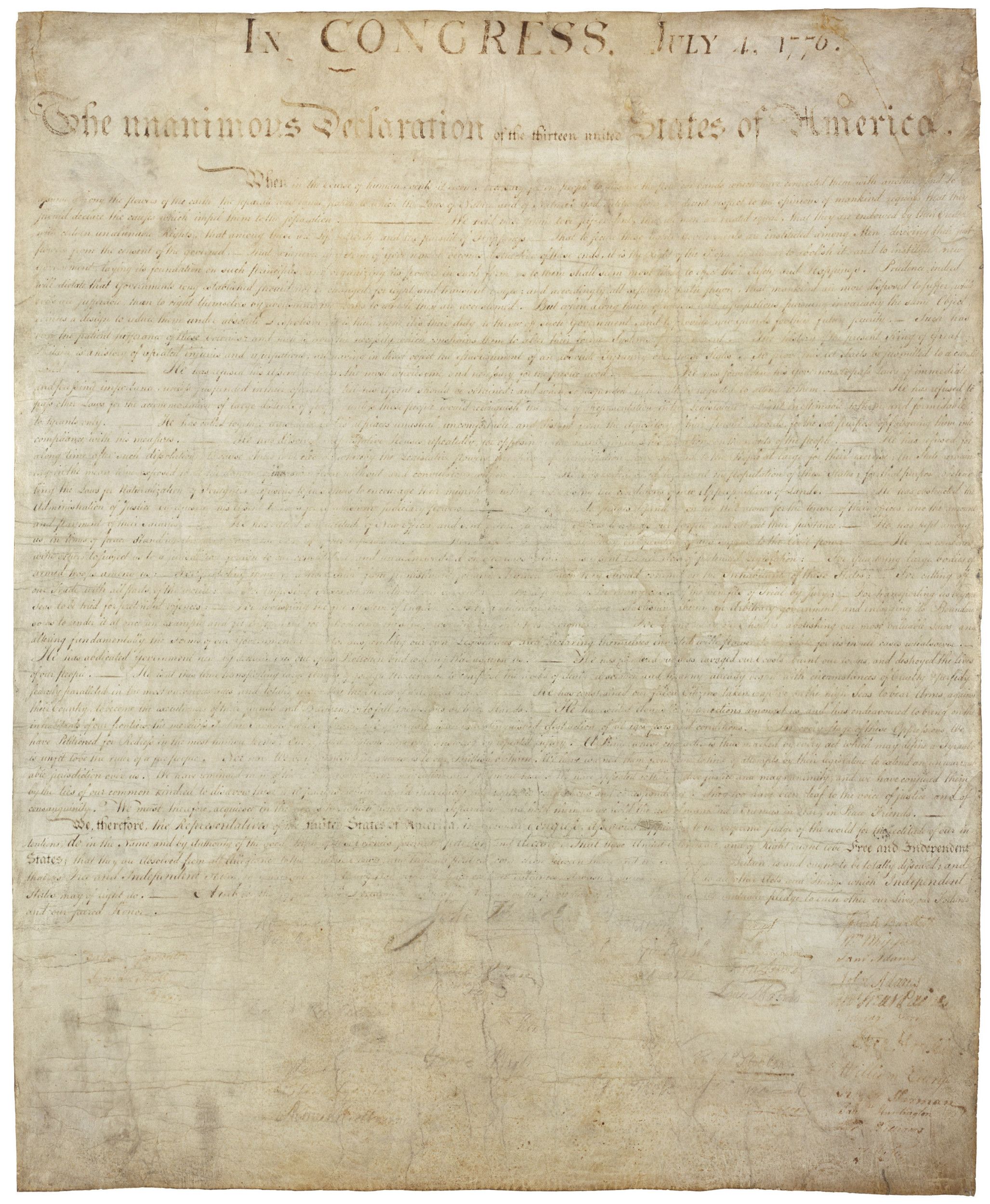
3
Activity Element
Sketch of British and American Lines and Fortifications in Boston Area by John Trumbull
Page 1
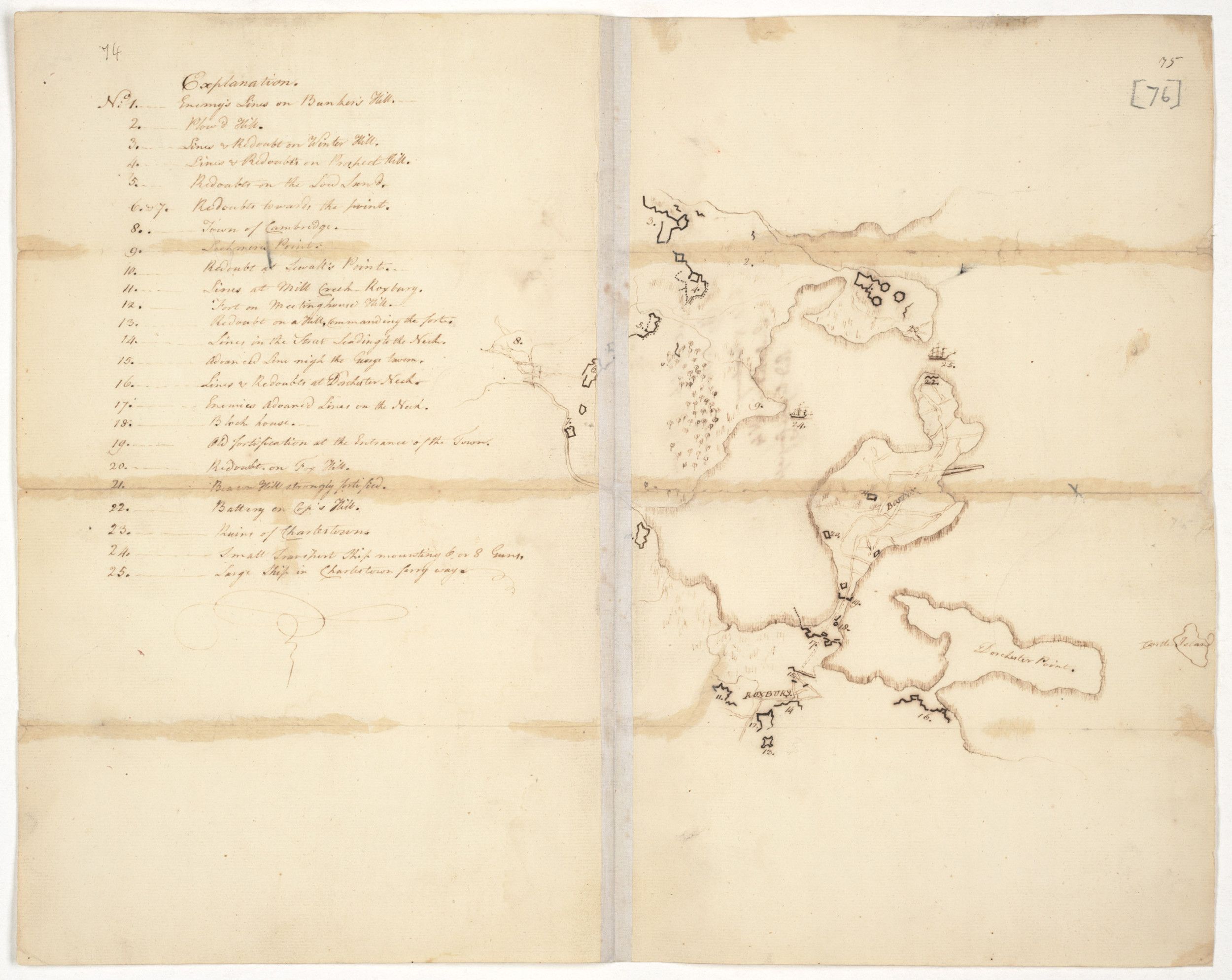
4
Activity Element
The Destruction of Tea at Boston Harbor. 1773. Copy of lithograph by Sarony & Major, 1846
Page 2
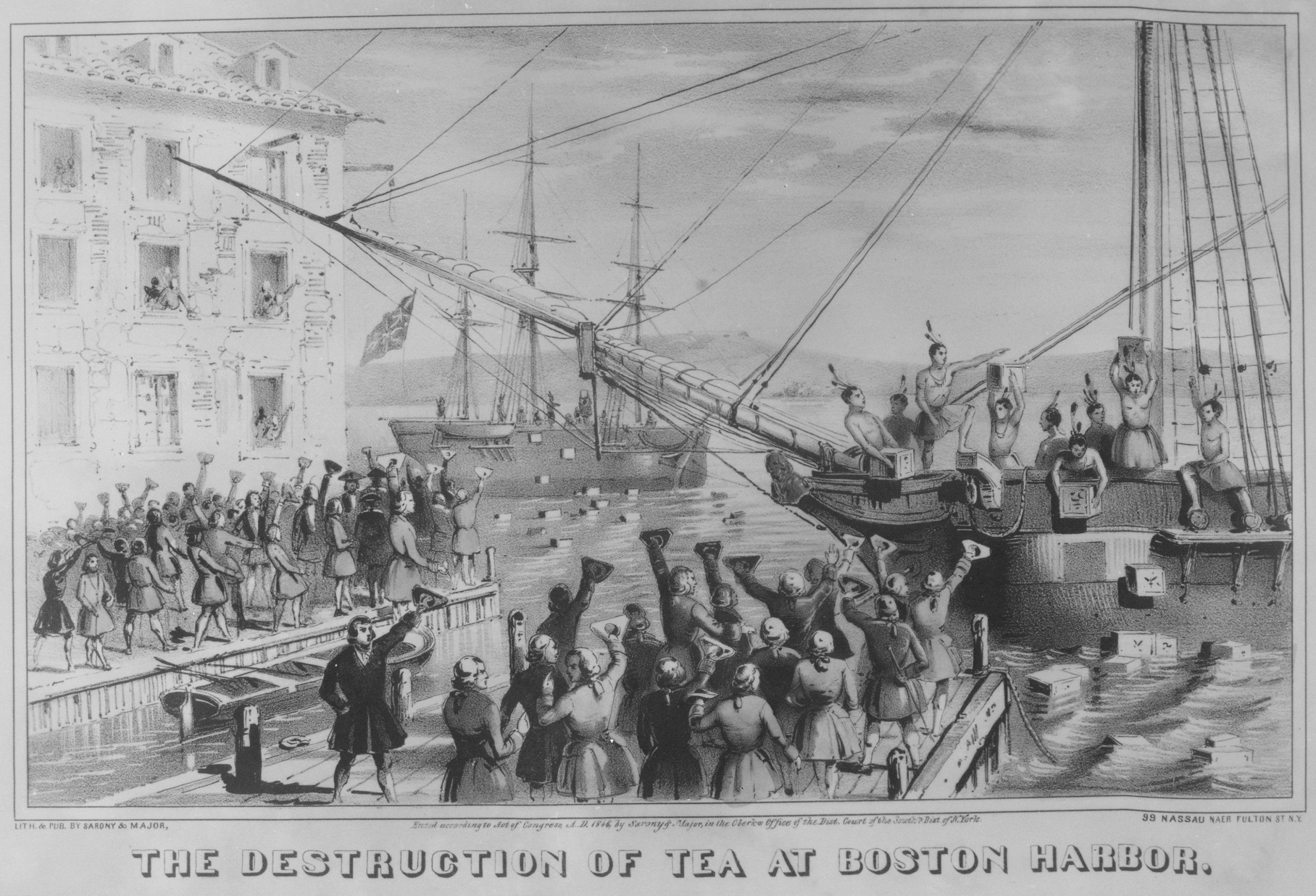
5
Activity Element
Adoption of the Resolution Calling for Independence from England
Page 2
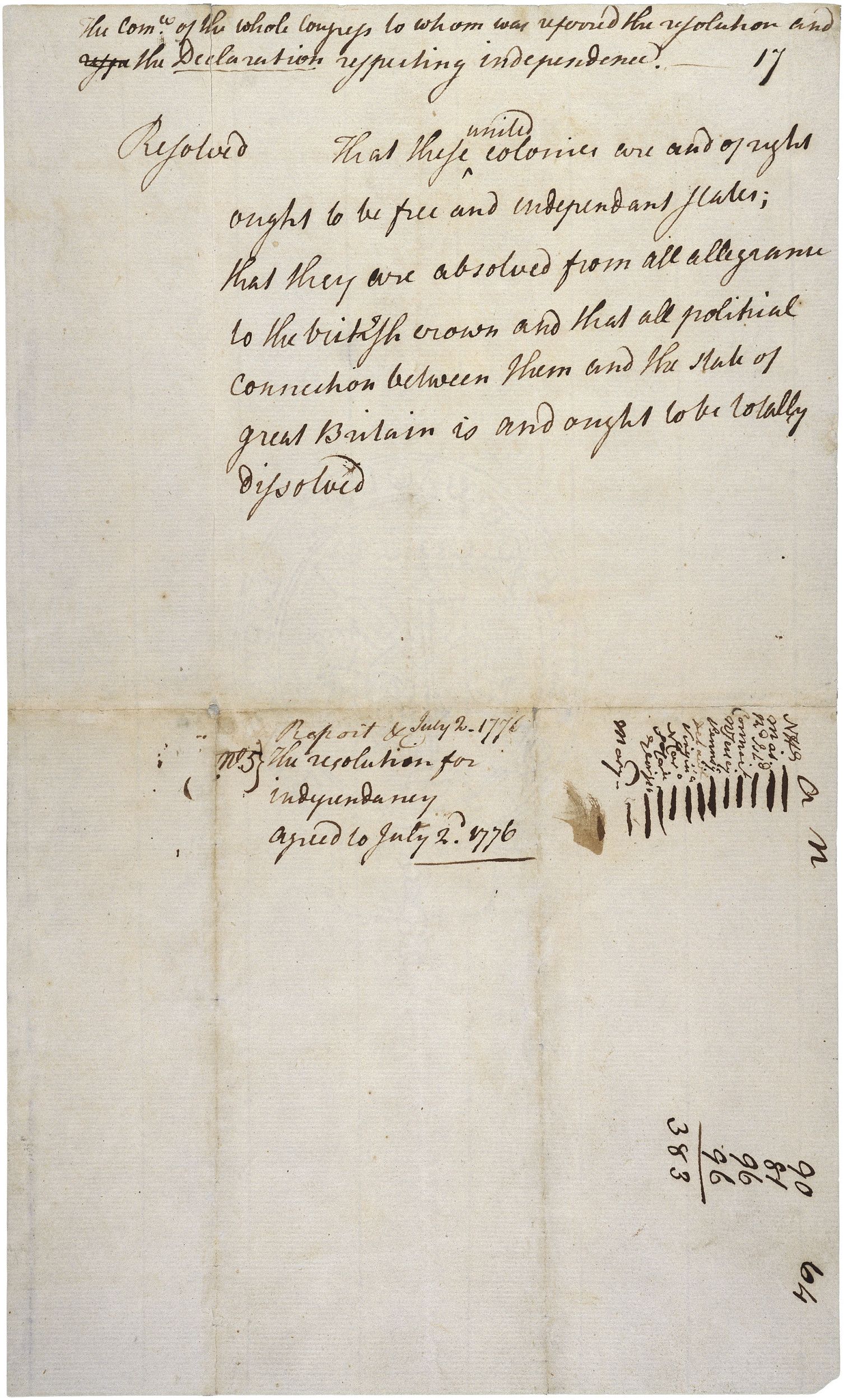
6
Activity Element
Boston Massacre, March 5, 1770. Copy of chromolithograph by John Bufford after William L. Champney, circa 1856
Page 1
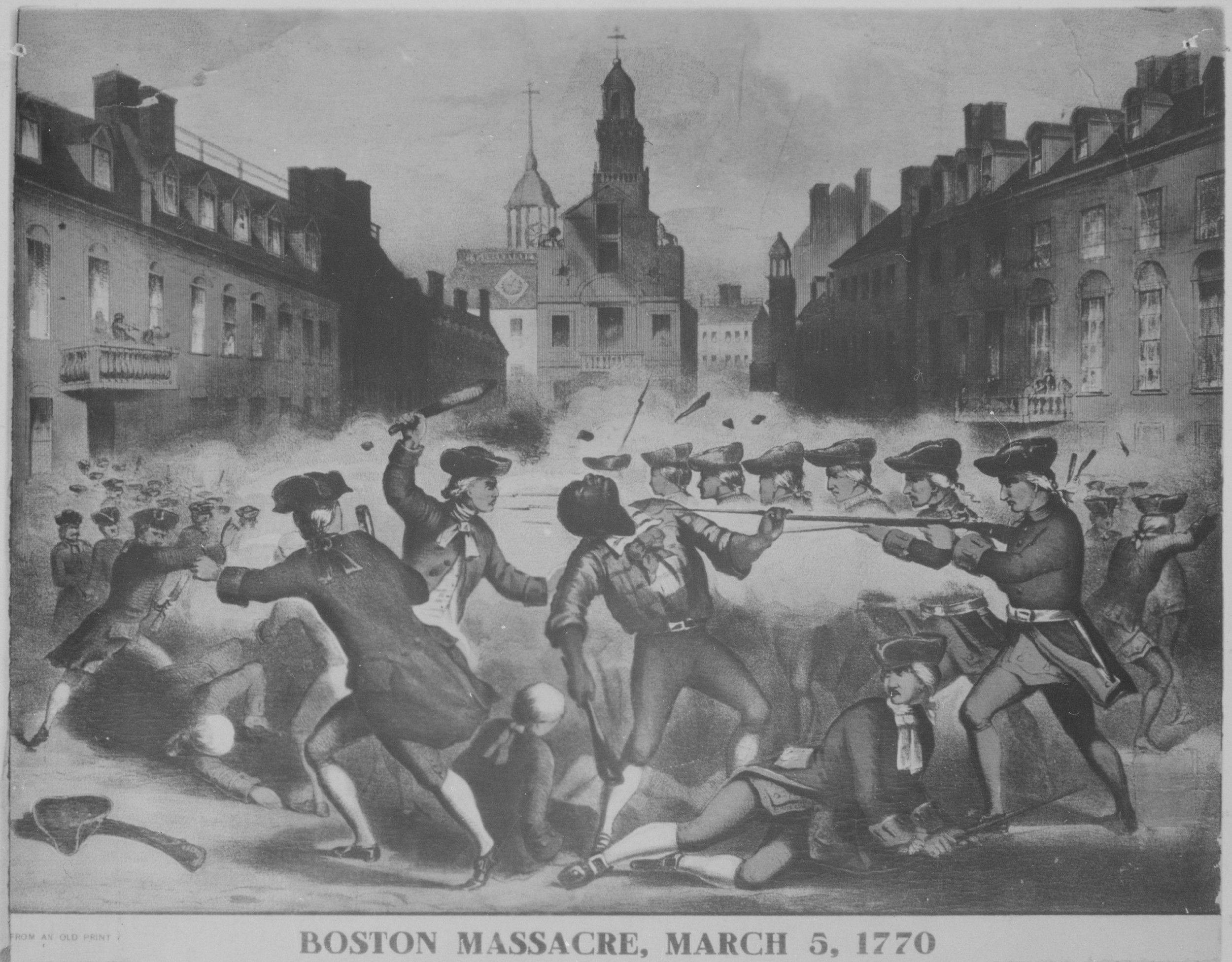
7
Activity Element
Drafting the Declaration of Independence. The Committee - Franklin, Jefferson, Adams, Livingston and Sherman. Copy of engraving after Alonzo Chappel.
Page 1
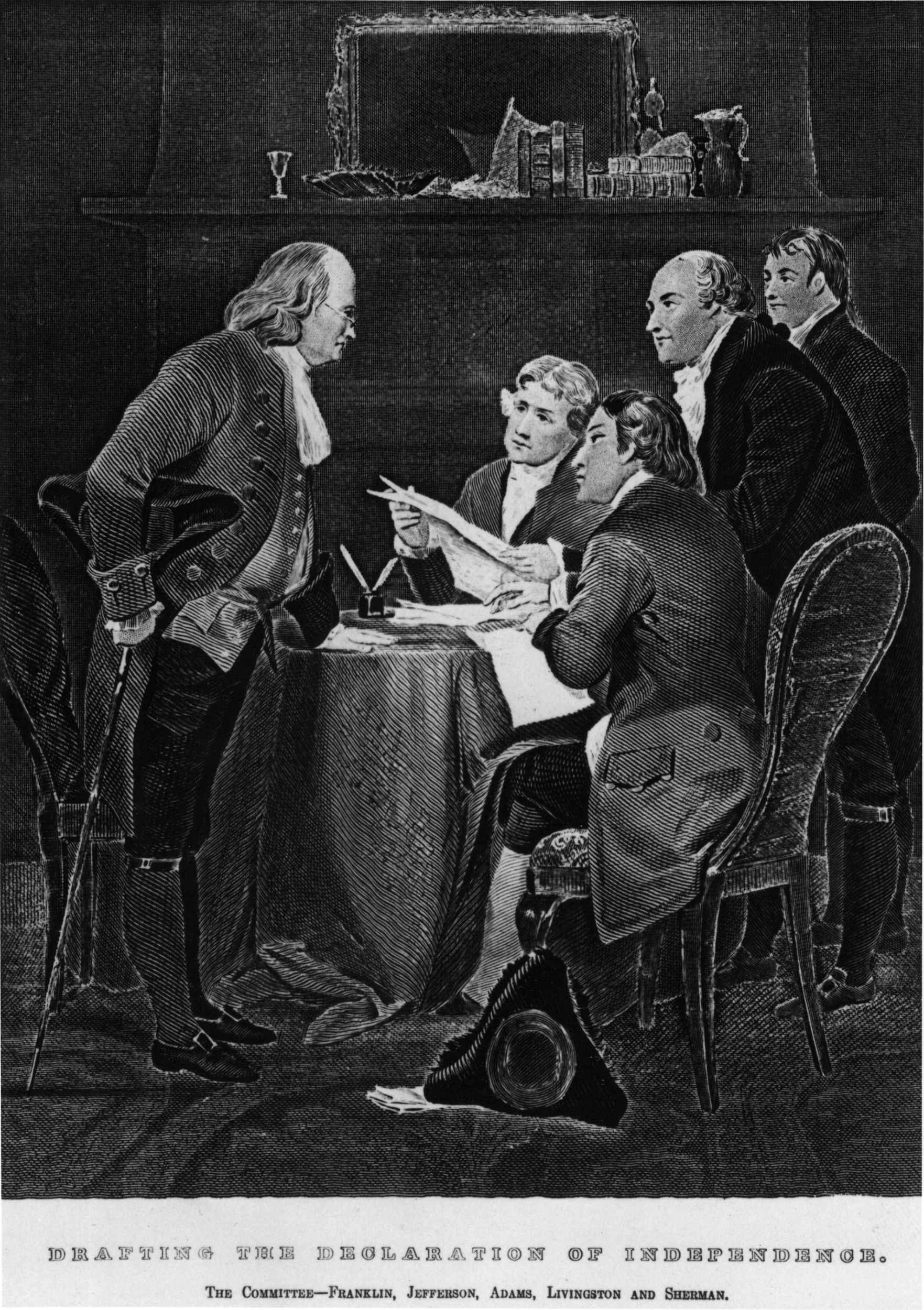
8
Activity Element
Reading of the Declaration of Independence from the East balcony of the Old State House, Boston, Massachusetts July 18, 1776. Copy of artwork.,
Page 2

9
Activity Element
View of The Attack on Bunker's Hill, with the Burning of Charles Town, June 17, 1775. Copy of engraving by Lodge after Millar, circa 1775-80
Page 1
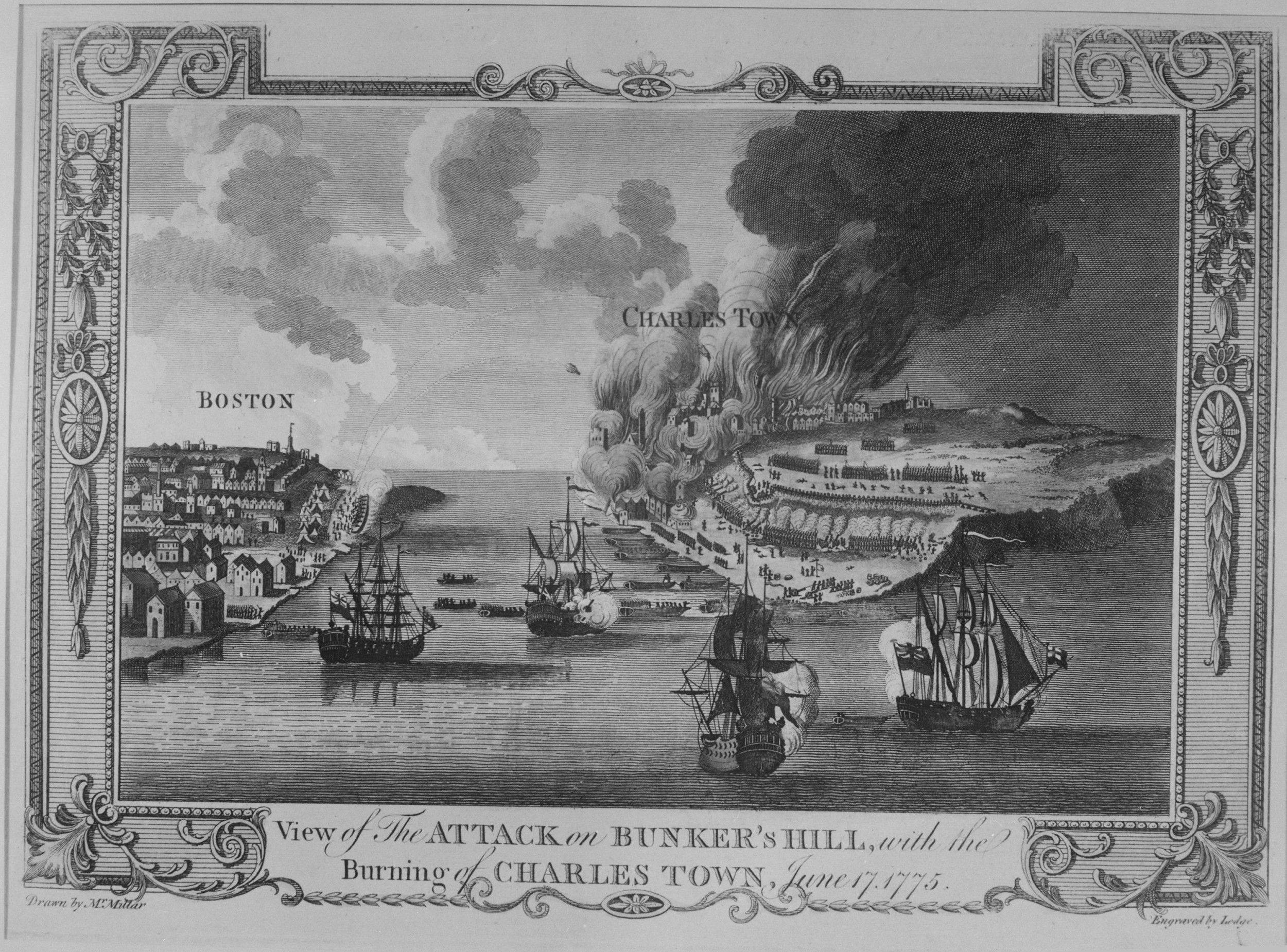
10
Activity Element
Paul Revere's ride
Page 1
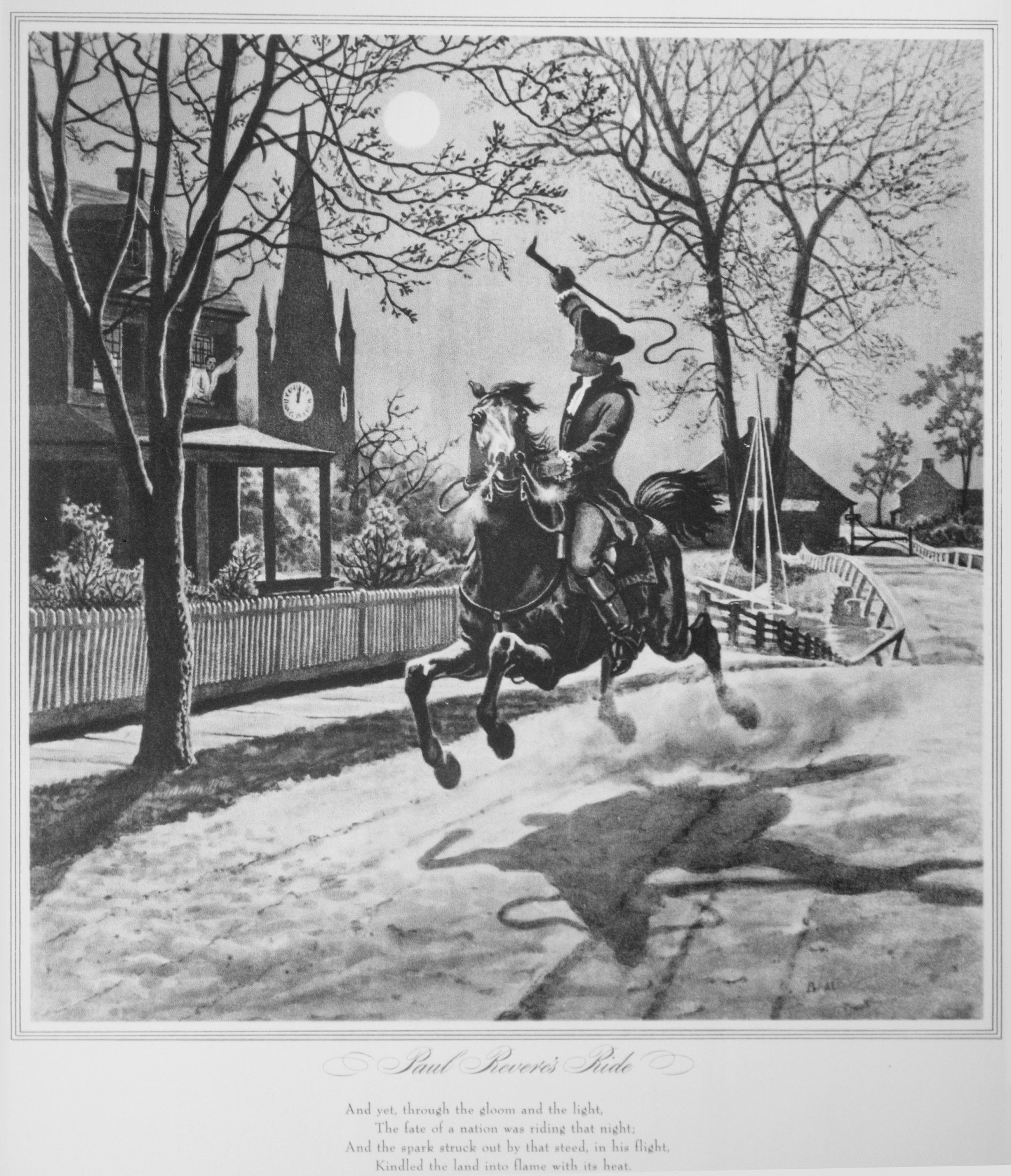
Conclusion
Prequel to Independence
Finding a Sequence
These events are, of course, not the only important events in this story. Write 1-3 paragraphs in which you describe the key events leading up to Independence. As examples, include each of these events in chronological order. Include the reasons that each of these is important, that is, how each event contributed to Independence and why it matters. Remember to include a knock-out topic sentence and a strong summative conclusion. Consider creating an illustrated timeline, newspaper, or dramatic presentation based on these documents. You might incorporate music of the era and additional resources.Your Response
Document
Engrossed Declaration of Independence
7/4/1776 - 8/2/1776
On July 4, 1776, the Second Continental Congress adopted the Declaration of Independence in which the American colonies set forth a list of grievances against the British Crown and declared they were breaking from British rule to form free and independent states.
The Continental Congress had, on June 10, appointed a committee of five to draft a statement of independence for the colonies. The committee included Thomas Jefferson, John Adams, Benjamin Franklin, Robert R. Livingston, and Roger Sherman, with the actual writing delegated to Jefferson.
Jefferson drafted the statement between June 11 and 28, submitted drafts to Adams and Franklin who made some changes, and then presented the draft to the Continental Congress following the July 2nd adoption of the independence section of the Lee Resolution. The congressional revision process took all of July 3rd and most of July 4th. Finally, in the afternoon of July 4th, the Declaration was adopted.
On July 19, Congress resolved that the Declaration passed on the 4th be fairly "engrossed" on parchment with a new title, "the unanimous declaration of the thirteen united states of America," and signed by every member of Congress. (Engrossing is the process of copying an official document in a large hand. The engrosser of the Declaration was probably Timothy Matlock, an assistant to Charles Thomson, secretary to the Congress.)
Although it bears the date "July 4, 1776," the engrossed Declaration was signed on August 2, by members of the Continental Congress who were present that day and later by other members of Congress. John Hancock, the President of the Congress, signed the engrossed copy with a bold signature. The other delegates, following custom, signed beginning at the right with the signatures arranged by states from northernmost New Hampshire to southernmost Georgia. Although all delegates were not present on August 2nd, 56 delegates eventually signed the document. Late signers were Elbridge Gerry, Oliver Wolcott, Lewis Morris, Thomas McKean, and Matthew Thornton, who was unable to place his signature with the other New Hampshire delegates due to a lack of space. Some delegates, including Robert R. Livingston of New York, a member of the drafting committee, never signed the Declaration.
The King of England considered members of the Second Continental Congress to be rebels and traitors. Affixing one's name to this document meant pledging your life, fortune and your sacred honor to the cause of freedom. While none of the signers of the Declaration of Independence was actually put to death for this act, many suffered consequences during the course of the Revolution. Fifteen of the signers had their homes destroyed; others were punished indirectly, through their wives and children. By the end of the Revolutionary War, more than one-half of the signers suffered physical harm, imprisonment, property destruction, or other penalties for their acts.
This document was featured in “On the Other Side” in the October 2004 National Council for the Social Studies (NCSS) publication Social Education.
The Continental Congress had, on June 10, appointed a committee of five to draft a statement of independence for the colonies. The committee included Thomas Jefferson, John Adams, Benjamin Franklin, Robert R. Livingston, and Roger Sherman, with the actual writing delegated to Jefferson.
Jefferson drafted the statement between June 11 and 28, submitted drafts to Adams and Franklin who made some changes, and then presented the draft to the Continental Congress following the July 2nd adoption of the independence section of the Lee Resolution. The congressional revision process took all of July 3rd and most of July 4th. Finally, in the afternoon of July 4th, the Declaration was adopted.
On July 19, Congress resolved that the Declaration passed on the 4th be fairly "engrossed" on parchment with a new title, "the unanimous declaration of the thirteen united states of America," and signed by every member of Congress. (Engrossing is the process of copying an official document in a large hand. The engrosser of the Declaration was probably Timothy Matlock, an assistant to Charles Thomson, secretary to the Congress.)
Although it bears the date "July 4, 1776," the engrossed Declaration was signed on August 2, by members of the Continental Congress who were present that day and later by other members of Congress. John Hancock, the President of the Congress, signed the engrossed copy with a bold signature. The other delegates, following custom, signed beginning at the right with the signatures arranged by states from northernmost New Hampshire to southernmost Georgia. Although all delegates were not present on August 2nd, 56 delegates eventually signed the document. Late signers were Elbridge Gerry, Oliver Wolcott, Lewis Morris, Thomas McKean, and Matthew Thornton, who was unable to place his signature with the other New Hampshire delegates due to a lack of space. Some delegates, including Robert R. Livingston of New York, a member of the drafting committee, never signed the Declaration.
The King of England considered members of the Second Continental Congress to be rebels and traitors. Affixing one's name to this document meant pledging your life, fortune and your sacred honor to the cause of freedom. While none of the signers of the Declaration of Independence was actually put to death for this act, many suffered consequences during the course of the Revolution. Fifteen of the signers had their homes destroyed; others were punished indirectly, through their wives and children. By the end of the Revolutionary War, more than one-half of the signers suffered physical harm, imprisonment, property destruction, or other penalties for their acts.
This document was featured in “On the Other Side” in the October 2004 National Council for the Social Studies (NCSS) publication Social Education.
Transcript
IN CONGRESS, July 4, 1776.The unanimous Declaration of the thirteen united States of America,
When in the Course of human events, it becomes necessary for one people to dissolve the political bands which have connected them with another, and to assume among the powers of the earth, the separate and equal station to which the Laws of Nature and of Nature's God entitle them, a decent respect to the opinions of mankind requires that they should declare the causes which impel them to the separation.
We hold these truths to be self-evident, that all men are created equal, that they are endowed by their Creator with certain unalienable Rights, that among these are Life, Liberty and the pursuit of Happiness.--That to secure these rights, Governments are instituted among Men, deriving their just powers from the consent of the governed, --That whenever any Form of Government becomes destructive of these ends, it is the Right of the People to alter or to abolish it, and to institute new Government, laying its foundation on such principles and organizing its powers in such form, as to them shall seem most likely to effect their Safety and Happiness. Prudence, indeed, will dictate that Governments long established should not be changed for light and transient causes; and accordingly all experience hath shewn, that mankind are more disposed to suffer, while evils are sufferable, than to right themselves by abolishing the forms to which they are accustomed. But when a long train of abuses and usurpations, pursuing invariably the same Object evinces a design to reduce them under absolute Despotism, it is their right, it is their duty, to throw off such Government, and to provide new Guards for their future security.--Such has been the patient sufferance of these Colonies; and such is now the necessity which constrains them to alter their former Systems of Government. The history of the present King of Great Britain is a history of repeated injuries and usurpations, all having in direct object the establishment of an absolute Tyranny over these States. To prove this, let Facts be submitted to a candid world.
He has refused his Assent to Laws, the most wholesome and necessary for the public good.
He has forbidden his Governors to pass Laws of immediate and pressing importance, unless suspended in their operation till his Assent should be obtained; and when so suspended, he has utterly neglected to attend to them.
He has refused to pass other Laws for the accommodation of large districts of people, unless those people would relinquish the right of Representation in the Legislature, a right inestimable to them and formidable to tyrants only.
He has called together legislative bodies at places unusual, uncomfortable, and distant from the depository of their public Records, for the sole purpose of fatiguing them into compliance with his measures.
He has dissolved Representative Houses repeatedly, for opposing with manly firmness his invasions on the rights of the people.
He has refused for a long time, after such dissolutions, to cause others to be elected; whereby the Legislative powers, incapable of Annihilation, have returned to the People at large for their exercise; the State remaining in the mean time exposed to all the dangers of invasion from without, and convulsions within.
He has endeavoured to prevent the population of these States; for that purpose obstructing the Laws for Naturalization of Foreigners; refusing to pass others to encourage their migrations hither, and raising the conditions of new Appropriations of Lands.
He has obstructed the Administration of Justice, by refusing his Assent to Laws for establishing Judiciary powers.
He has made Judges dependent on his Will alone, for the tenure of their offices, and the amount and payment of their salaries.
He has erected a multitude of New Offices, and sent hither swarms of Officers to harrass our people, and eat out their substance.
He has kept among us, in times of peace, Standing Armies without the Consent of our legislatures.
He has affected to render the Military independent of and superior to the Civil power.
He has combined with others to subject us to a jurisdiction foreign to our constitution, and unacknowledged by our laws; giving his Assent to their Acts of pretended Legislation:
For Quartering large bodies of armed troops among us:
For protecting them, by a mock Trial, from punishment for any Murders which they should commit on the Inhabitants of these States:
For cutting off our Trade with all parts of the world:
For imposing Taxes on us without our Consent:
For depriving us in many cases, of the benefits of Trial by Jury:
For transporting us beyond Seas to be tried for pretended offences
For abolishing the free System of English Laws in a neighbouring Province, establishing therein an Arbitrary government, and enlarging its Boundaries so as to render it at once an example and fit instrument for introducing the same absolute rule into these Colonies:
For taking away our Charters, abolishing our most valuable Laws, and altering fundamentally the Forms of our Governments:
For suspending our own Legislatures, and declaring themselves invested with power to legislate for us in all cases whatsoever.
He has abdicated Government here, by declaring us out of his Protection and waging War against us.
He has plundered our seas, ravaged our Coasts, burnt our towns, and destroyed the lives of our people.
He is at this time transporting large Armies of foreign Mercenaries to compleat the works of death, desolation and tyranny, already begun with circumstances of Cruelty & perfidy scarcely paralleled in the most barbarous ages, and totally unworthy the Head of a civilized nation.
He has constrained our fellow Citizens taken Captive on the high Seas to bear Arms against their Country, to become the executioners of their friends and Brethren, or to fall themselves by their Hands.
He has excited domestic insurrections amongst us, and has endeavoured to bring on the inhabitants of our frontiers, the merciless Indian Savages, whose known rule of warfare, is an undistinguished destruction of all ages, sexes and conditions.
In every stage of these Oppressions We have Petitioned for Redress in the most humble terms: Our repeated Petitions have been answered only by repeated injury. A Prince whose character is thus marked by every act which may define a Tyrant, is unfit to be the ruler of a free people.
Nor have We been wanting in attentions to our Brittish brethren. We have warned them from time to time of attempts by their legislature to extend an unwarrantable jurisdiction over us. We have reminded them of the circumstances of our emigration and settlement here. We have appealed to their native justice and magnanimity, and we have conjured them by the ties of our common kindred to disavow these usurpations, which, would inevitably interrupt our connections and correspondence. They too have been deaf to the voice of justice and of consanguinity. We must, therefore, acquiesce in the necessity, which denounces our Separation, and hold them, as we hold the rest of mankind, Enemies in War, in Peace Friends.
We, therefore, the Representatives of the united States of America, in General Congress, Assembled, appealing to the Supreme Judge of the world for the rectitude of our intentions, do, in the Name, and by Authority of the good People of these Colonies, solemnly publish and declare, That these United Colonies are, and of Right ought to be Free and Independent States; that they are Absolved from all Allegiance to the British Crown, and that all political connection between them and the State of Great Britain, is and ought to be totally dissolved; and that as Free and Independent States, they have full Power to levy War, conclude Peace, contract Alliances, establish Commerce, and to do all other Acts and Things which Independent States may of right do. And for the support of this Declaration, with a firm reliance on the protection of divine Providence, we mutually pledge to each other our Lives, our Fortunes and our sacred Honor.
The 56 signatures on the Declaration appear in the positions indicated:
Column 1
Georgia:
Button Gwinnett
Lyman Hall
George Walton
Column 2
North Carolina:
William Hooper
Joseph Hewes
John Penn
South Carolina:
Edward Rutledge
Thomas Heyward, Jr.
Thomas Lynch, Jr.
Arthur Middleton
Column 3
Massachusetts:
John Hancock
Maryland:
Samuel Chase
William Paca
Thomas Stone
Charles Carroll of Carrollton
Virginia:
George Wythe
Richard Henry Lee
Thomas Jefferson
Benjamin Harrison
Thomas Nelson, Jr.
Francis Lightfoot Lee
Carter Braxton
Column 4
Pennsylvania:
Robert Morris
Benjamin Rush
Benjamin Franklin
John Morton
George Clymer
James Smith
George Taylor
James Wilson
George Ross
Delaware:
Caesar Rodney
George Read
Thomas McKean
Column 5
New York:
William Floyd
Philip Livingston
Francis Lewis
Lewis Morris
New Jersey:
Richard Stockton
John Witherspoon
Francis Hopkinson
John Hart
Abraham Clark
Column 6
New Hampshire:
Josiah Bartlett
William Whipple
Massachusetts:
Samuel Adams
John Adams
Robert Treat Paine
Elbridge Gerry
Rhode Island:
Stephen Hopkins
William Ellery
Connecticut:
Roger Sherman
Samuel Huntington
William Williams
Oliver Wolcott
New Hampshire:
Matthew Thornton
This primary source comes from the Records of the Continental and Confederation Congresses and the Constitutional Convention.
National Archives Identifier: 1419123
Full Citation: Engrossed Declaration of Independence; 7/4/1776 - 8/2/1776; Miscellaneous Papers of the Continental Congress, 1774 - 1789; Records of the Continental and Confederation Congresses and the Constitutional Convention, ; National Archives Building, Washington, DC. [Online Version, https://docsteach.org/documents/document/the-declaration-of-independence, April 26, 2024]Engrossed Declaration of Independence
Page 1

Engrossed Declaration of Independence
Page 2
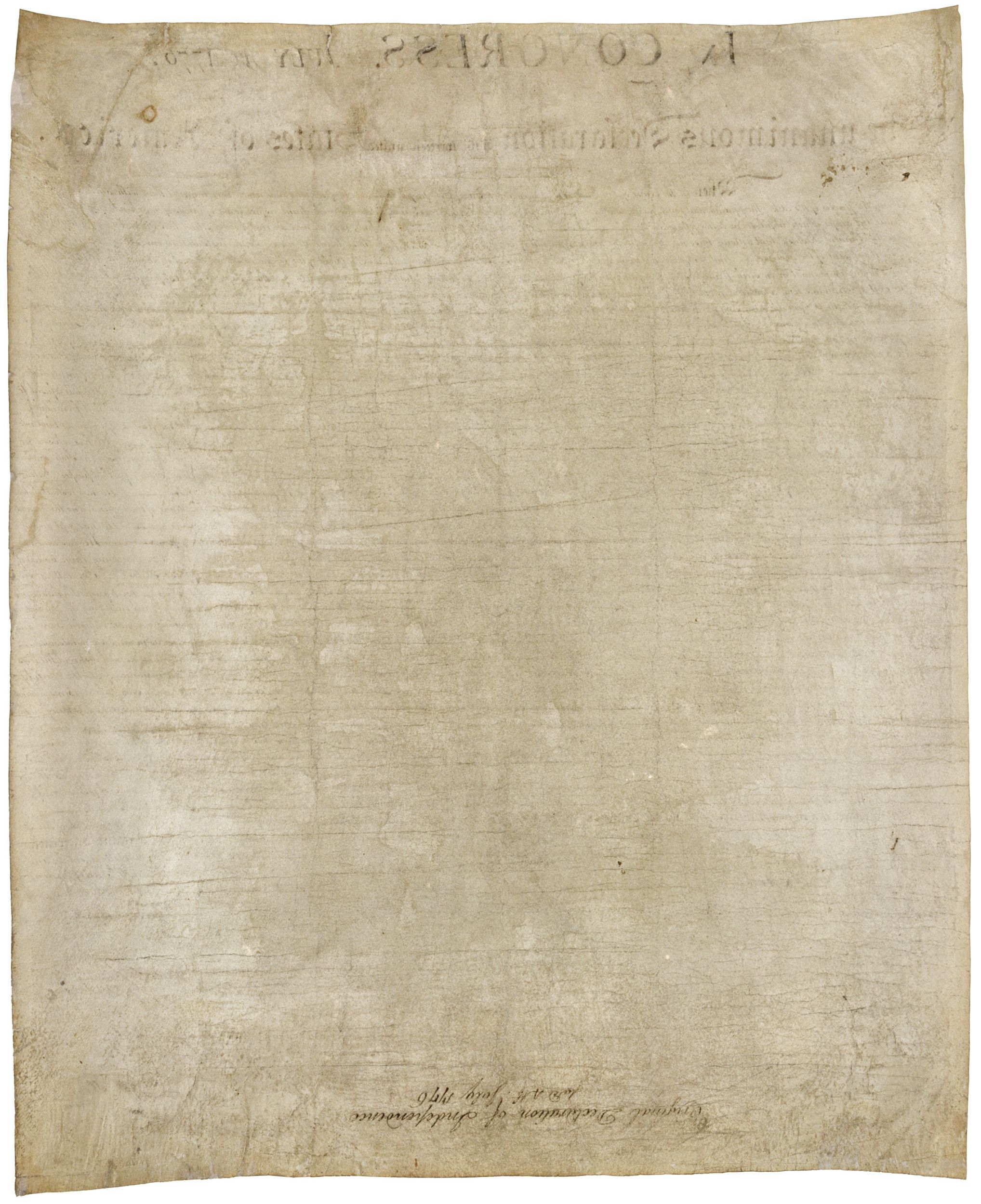
Document
Adoption of the Resolution Calling for Independence from England
7/2/1776
In the early 1770s, more and more colonists became convinced that the British Parliament intended to take away their freedom. After fighting broke out in Massachusetts in the spring of 1775, the King declared the colonists "in a state of open and avowed rebellion." For the first time, many colonists began to seriously consider cutting ties with Britain.
The colonists elected delegates to attend a Continental Congress that eventually became the governing body of the union during the Revolution. Its second meeting convened in Philadelphia in 1775. The delegates to Congress adopted strict rules of secrecy to protect the cause of American liberty and their own lives. In less than a year, most of the delegates abandoned hope of reconciliation with Britain.
On June 7, 1776, Richard Henry Lee introduced a resolution "that these united colonies are and of right ought to be free and independent states," acting under the instruction of the Virginia Convention. The Lee Resolution contained three parts: a declaration of independence, a call to form foreign alliances, and "a plan for confederation."
On June 11, 1776, the Congress appointed three concurrent committees in response to the Lee Resolution: one to draft a declaration of independence, a second to draw up a plan "for forming foreign alliances," and a third to "prepare and digest the form of a confederation."
Because many members of the Congress believed the actions Lee proposed to be premature or wanted instructions from their colonies before voting, approval was deferred until July 2. On that date, Congress adopted the first part (the declaration).
The document seen here shows the vote on the resolution — the affirmative votes of 12 colonies are listed at the right. New York cast no vote until the newly elected New York Convention upheld the Declaration of Independence on July 9, 1776.
The plan for making treaties was not approved until September of 1776; the plan of confederation was delayed until November of 1777.
The colonists elected delegates to attend a Continental Congress that eventually became the governing body of the union during the Revolution. Its second meeting convened in Philadelphia in 1775. The delegates to Congress adopted strict rules of secrecy to protect the cause of American liberty and their own lives. In less than a year, most of the delegates abandoned hope of reconciliation with Britain.
On June 7, 1776, Richard Henry Lee introduced a resolution "that these united colonies are and of right ought to be free and independent states," acting under the instruction of the Virginia Convention. The Lee Resolution contained three parts: a declaration of independence, a call to form foreign alliances, and "a plan for confederation."
On June 11, 1776, the Congress appointed three concurrent committees in response to the Lee Resolution: one to draft a declaration of independence, a second to draw up a plan "for forming foreign alliances," and a third to "prepare and digest the form of a confederation."
Because many members of the Congress believed the actions Lee proposed to be premature or wanted instructions from their colonies before voting, approval was deferred until July 2. On that date, Congress adopted the first part (the declaration).
The document seen here shows the vote on the resolution — the affirmative votes of 12 colonies are listed at the right. New York cast no vote until the newly elected New York Convention upheld the Declaration of Independence on July 9, 1776.
The plan for making treaties was not approved until September of 1776; the plan of confederation was delayed until November of 1777.
Transcript
The Com. of the Whole Congress to whom was referred the resolution and [illegible] the Declaration respecting independence.17
Resolved That these united colonies are and of right ought to be free and independence states; that they are absolved from all allegiance to the British crown and that all political connection between them and the state of great Britain is and ought to be totally dissolved.
July 2, 1776
No. 5 } Report of the resolution for independency agreed to July 2, 1776
[to the right of the just above section, written sideways from the right side of the paper are the following, fin this order, followed by a black line:]
A N
NHS ________
Mas. ________
Ro Isl. ________
Connect. ________
NJersey ________
Pennsy. ________
Delaware ________
Virginia ________
N Caro ________
S Carol ________
Georgia ________
Maryland ________
[At the bottom right corner of page, written sideways from top to bottom is:]
90
81
96
96
-------
383
64
[to the right of the just above section, written sideways from the right side of the paper are the following, fin this order, followed by a black line:]
A N
NHS ________
Mas. ________
Ro Isl. ________
Connect. ________
NJersey ________
Pennsy. ________
Delaware ________
Virginia ________
N Caro ________
S Carol ________
Georgia ________
Maryland ________
[At the bottom right corner of page, written sideways from top to bottom is:]
90
81
96
96
-------
383
64
This primary source comes from the Records of the Continental and Confederation Congresses and the Constitutional Convention.
National Archives Identifier: 301685
Full Citation: Adoption of the Resolution Calling for Independence from England; 7/2/1776; Reports on Administrative Affairs of the Congress; Papers of the Continental Congress, 1774 - 1789; Records of the Continental and Confederation Congresses and the Constitutional Convention, ; National Archives Building, Washington, DC. [Online Version, https://docsteach.org/documents/document/adoption-lee-resolution, April 26, 2024]Adoption of the Resolution Calling for Independence from England
Page 2
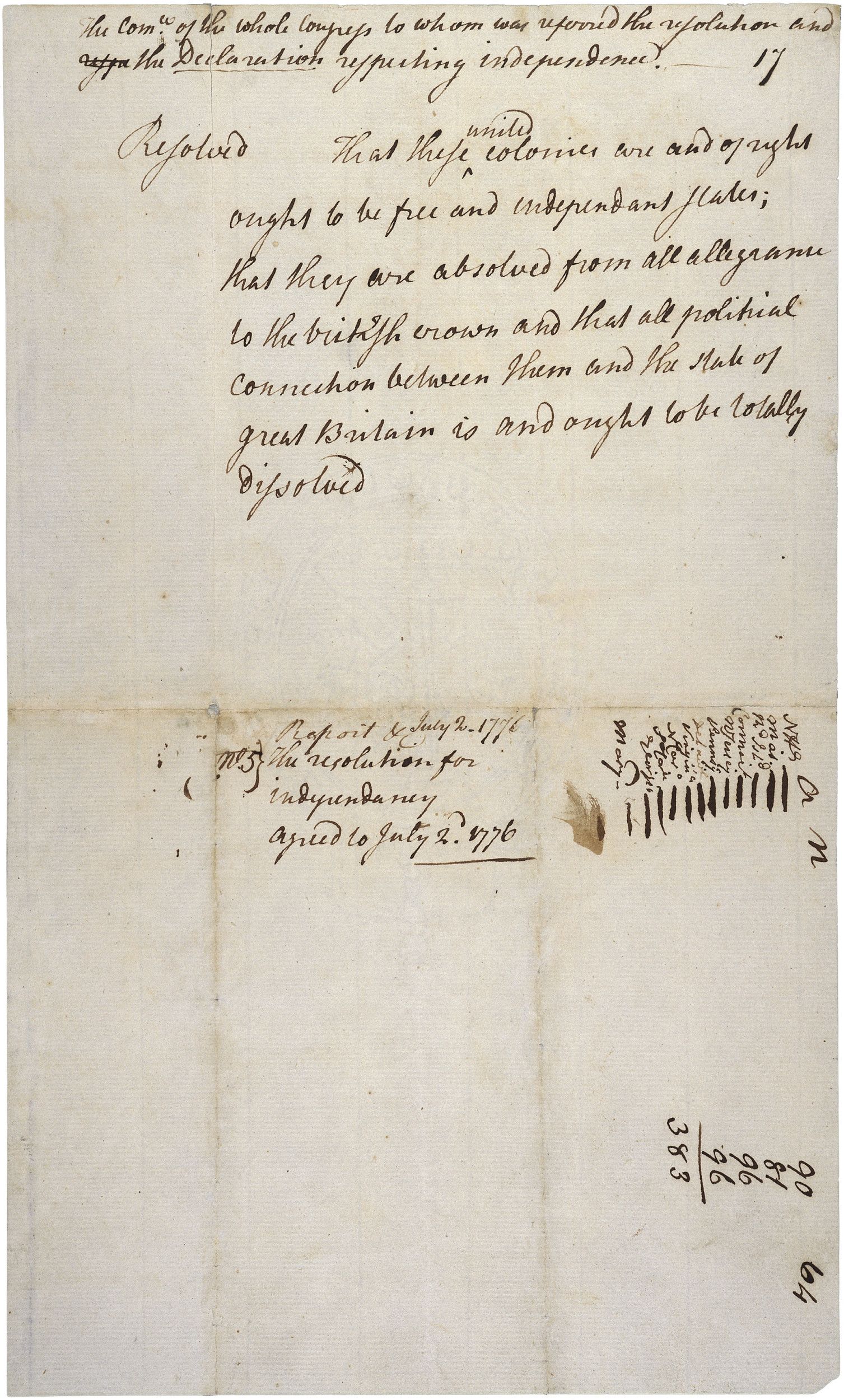
Document
View of The Attack on Bunker's Hill, with the Burning of Charles Town, June 17, 1775. Copy of engraving by Lodge after Millar, circa 1775-80
6/17/1775 (artwork ca. 1775-1780)
This is a copy of an engraving by John Lodge, based on a drawing by an artist identified as "Mr. Millar."
This primary source comes from the Records of Commissions of the Legislative Branch.
National Archives Identifier: 532896
Full Citation: Photograph 148-GW-448; View of The Attack on Bunker's Hill, with the Burning of Charles Town, June 17, 1775. Copy of engraving by Lodge after Millar, circa 1775-80; 6/17/1775 (artwork ca. 1775-1780); The George Washington Bicentennial Commission, 1931 - 1932; Records of Commissions of the Legislative Branch, ; National Archives at College Park, College Park, MD. [Online Version, https://docsteach.org/documents/document/view-bunker-hill, April 26, 2024]View of The Attack on Bunker's Hill, with the Burning of Charles Town, June 17, 1775. Copy of engraving by Lodge after Millar, circa 1775-80
Page 1
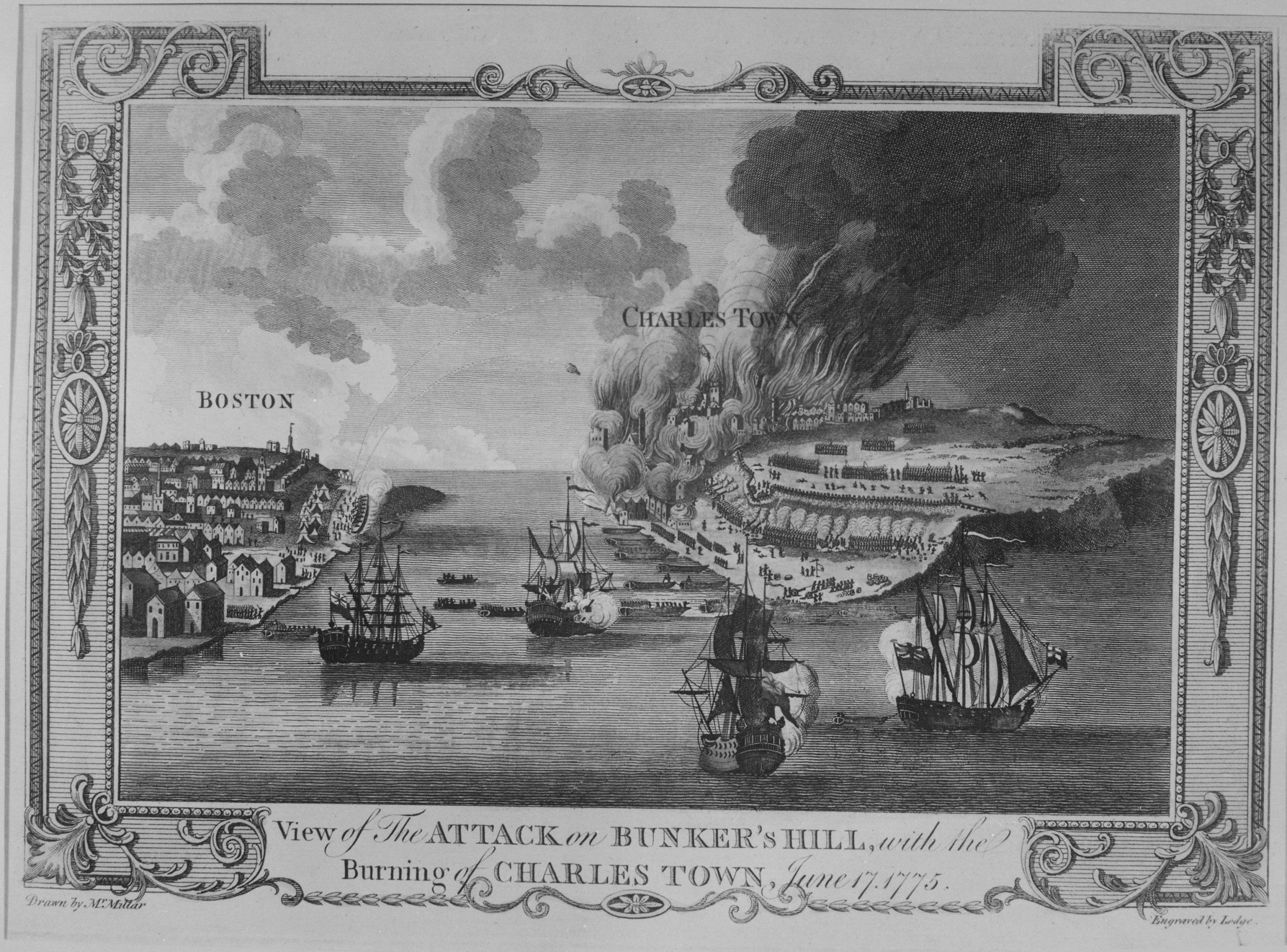
Document
Paul Revere's ride
4/19/1775 (artwork ca. 1942)
This is a copy of an illustration by Modern Enterprises. It was used as a feature story illustration by the Office of War Information's News and Features Bureau during World War II.
This primary source comes from the Records of the Office of War Information.
National Archives Identifier: 535723
Full Citation: Photograph 208-FS-3200(5); Paul Revere's ride; 4/19/1775 (artwork ca. 1942); Feature Story Illustrations, 1942 - 1946; Records of the Office of War Information, ; National Archives at College Park, College Park, MD. [Online Version, https://docsteach.org/documents/document/paul-reveres-ride, April 26, 2024]Paul Revere's ride
Page 1
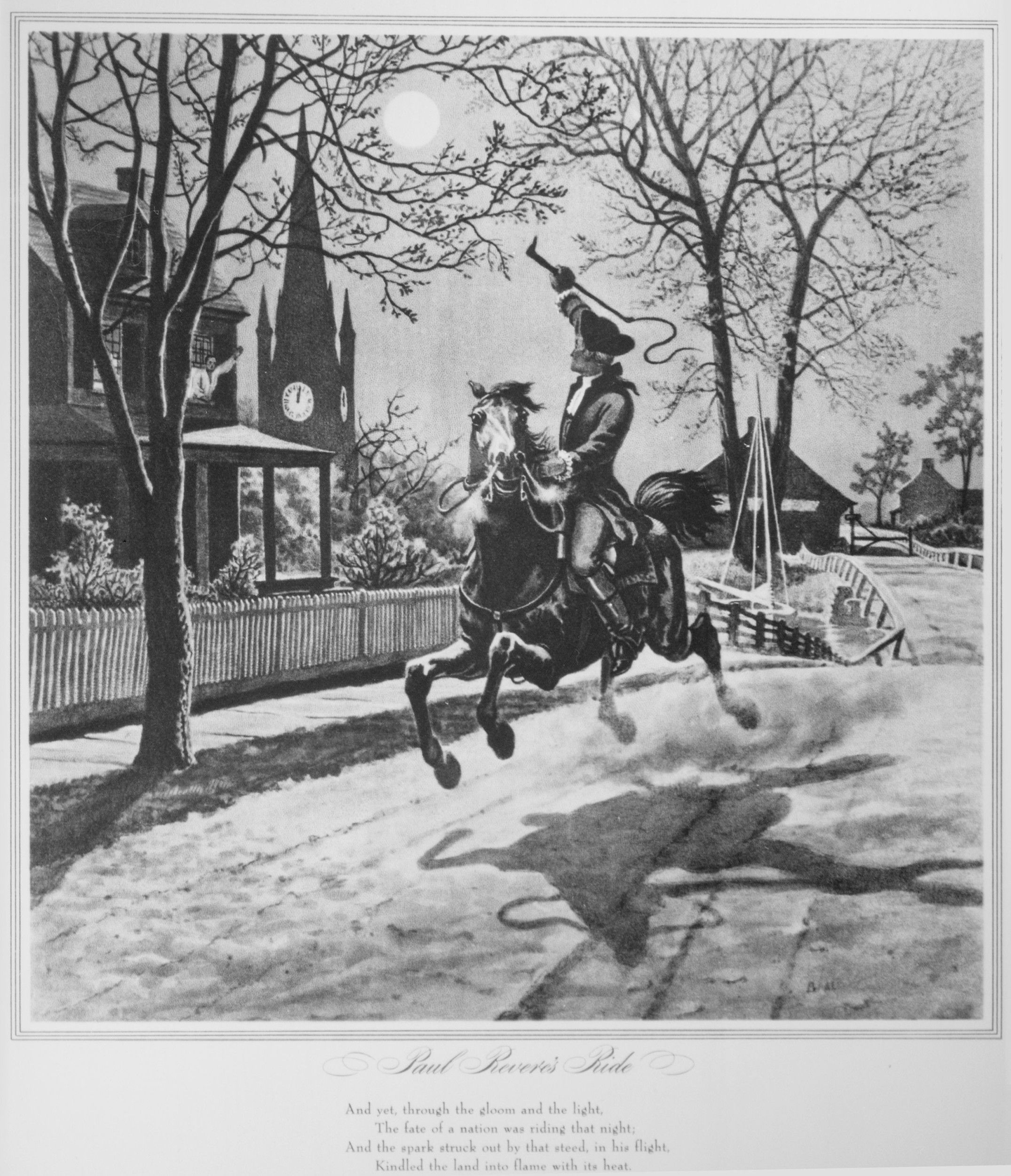
Document
Deposition of Captain John Parker Concerning the Battle at Lexington
4/25/1775
Less than a week after the events, on April 25, 1775, Capt. John Parker gave this account of the battle of Lexington, Massachusetts. After confronting the British Regulars, Parker ordered his men “to disperse and not to fire.” Suddenly a shot rang out, fired by an unknown person; the British reacted by firing, killing eight of Parker’s men. This deposition, which was delivered to the Massachusetts Assembly and later forwarded to the Continental Congress, presents the American perception of the battle.
This and other documents about the battles at Lexington and Concord are included in the Massachusetts State Papers from 1775 - 1787, in the Papers of the Continental Congress.
This and other documents about the battles at Lexington and Concord are included in the Massachusetts State Papers from 1775 - 1787, in the Papers of the Continental Congress.
Transcript
No 4. Lexington April 25th, 1775I John Parker, of lawful Age, and Commander of the Militia in Lexington, do testify & declare that on the 19th Instant, in the morning, about one of the Clock, being informed that there were a Number of Regular Officers riding up and down the Road, Stopping and insulting People as they passed the Road, and also was informed that a Number of Regular Troops were on their March from Boston, in order to take the Province Stores at Concord, ordered our Militia to meet on the Common in said Lexington, to consult what to do, and concluded not to be discovered nor meddle or make with said Regular Troops (if they should approach) unless they should insult or molest us - and upon their sudden Approach I immediately ordered our Militia to disperse and not to fire - Immediately said Troops made their Appearance and rushed furiously, fired up-on and killed eight of our Party, without receiving any Provocation therefor from us,
John Parker
(in bracket)
Middlesex Ss. April 25th, 1775. The above named John Parker personally appeared, and, after being duly cautioned to declare the whole Truth, made solemn Oath to the truth of the above Deposition by him subscribed
Coram
Wm Reed
Josiah Johnson (bracket) Just of Peace
Wm Stickney
Province of Massachusetts Bay, Charlestown Ss.
I Nathaniel Gorham, Notary and Tabellian Publick,
by lawful Authority duly admitted and sworn, hereby
certify all whom it ^doth or^ may concern, that William Reed,
Josiah Johnson and William Strikney Esq are three
of His Majesty's Justices of the Peace for the County of
Middlesex, and that full Faith & Credit is and ought to be
given to their transactions as such - In Witness whereof
I have hereunto set my Name and Seal this twenty
sixth Day of April, one Thousand Seven Hundred and
Seventy five.
Nathaniel Gorham Noty Pubk (LS)
The forgoing are true copies
attest Nath Gorham Noty Publick
This primary source comes from the Records of the Continental and Confederation Congresses and the Constitutional Convention.
National Archives Identifier: 595246
Full Citation: Deposition of Captain John Parker Concerning the Battle at Lexington; 4/25/1775; Massachusetts State Papers; Papers of the Continental Congress, 1774–1789; Records of the Continental and Confederation Congresses and the Constitutional Convention, ; National Archives Building, Washington, DC. [Online Version, https://docsteach.org/documents/document/john-parker-lexington, April 26, 2024]Deposition of Captain John Parker Concerning the Battle at Lexington
Page 1
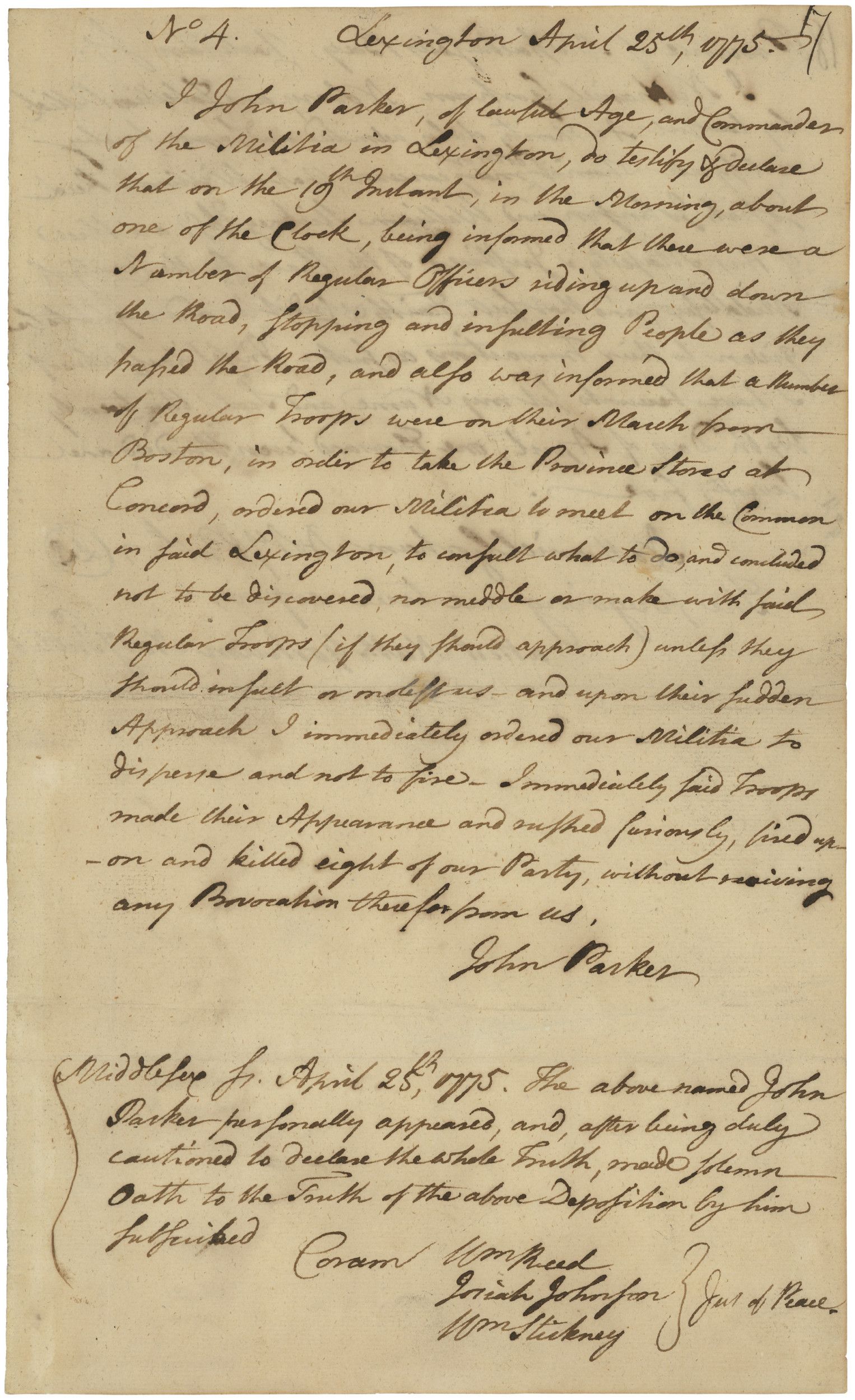
Deposition of Captain John Parker Concerning the Battle at Lexington
Page 2
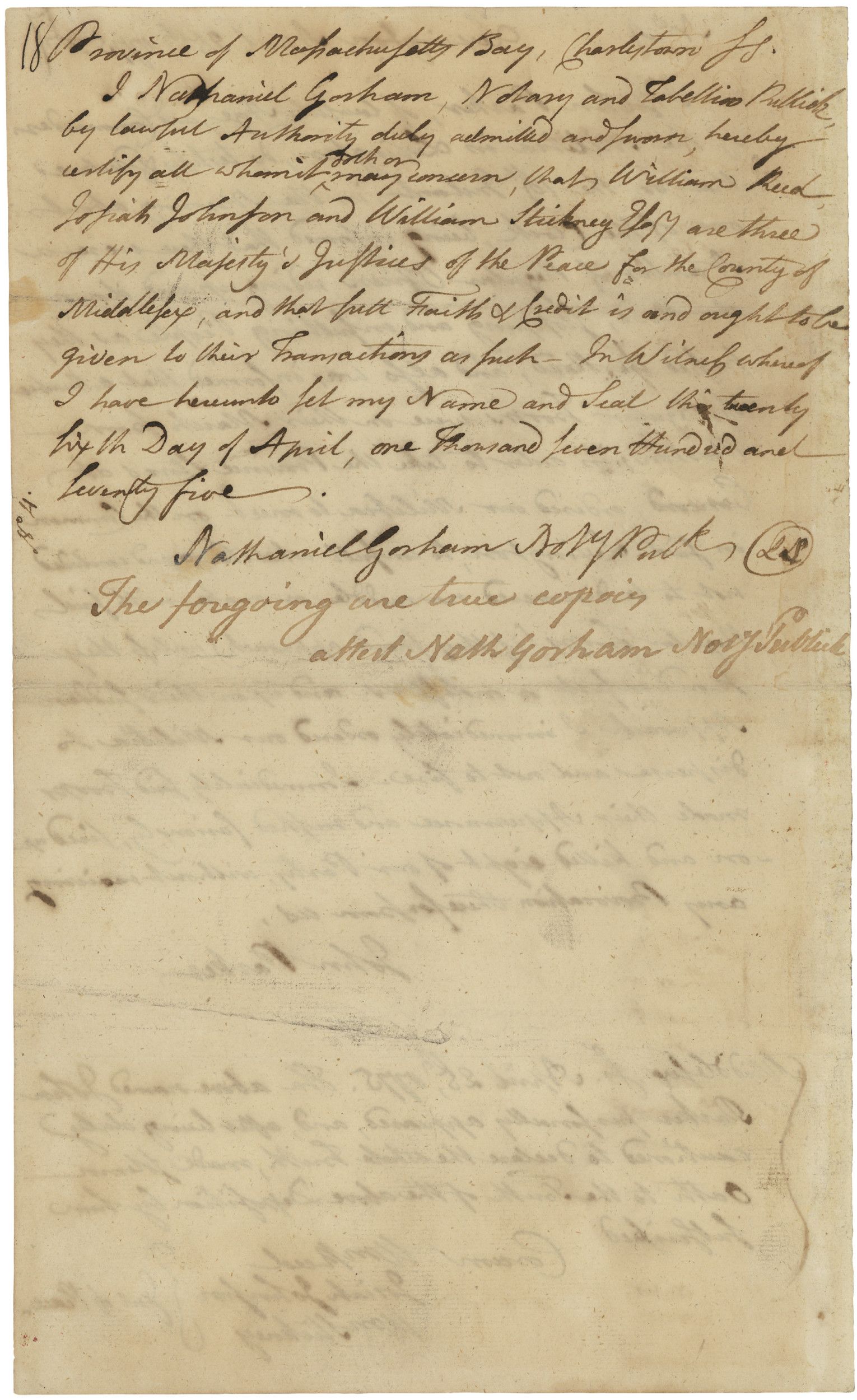
Document
Sketch of British and American Lines and Fortifications in Boston Area by John Trumbull
1775
This sketch of British and American lines and fortifications in the Boston area was drawn by John Trumbull.
This primary source comes from the Records of the Continental and Confederation Congresses and the Constitutional Convention.
National Archives Identifier: 5757356
Full Citation: Sketch of British and American Lines and Fortifications in Boston Area by John Trumbull; 1775; Letters from General George Washington, Commander in Chief of the Army; Papers of the Continental Congress, 1774 - 1789; Records of the Continental and Confederation Congresses and the Constitutional Convention, ; National Archives Building, Washington, DC. [Online Version, https://docsteach.org/documents/document/british-american-troops-boston, April 26, 2024]Sketch of British and American Lines and Fortifications in Boston Area by John Trumbull
Page 1
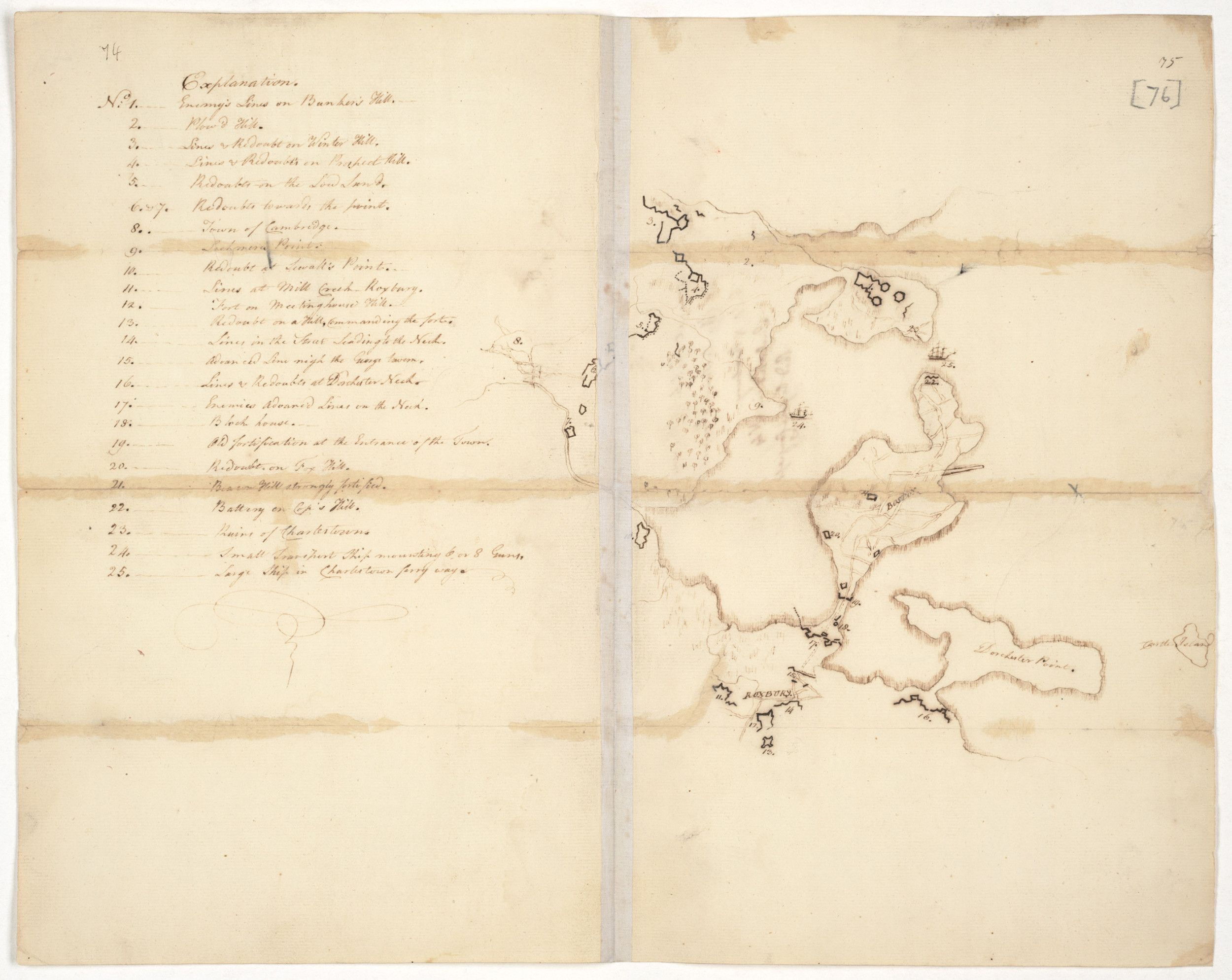
Document
Boston Massacre, March 5, 1770. Copy of chromolithograph by John Bufford after William L. Champney
3/5/1770 (artwork ca. 1856)
This is a copy of a chromolithograph (color print) by John Bufford after William L. Champney's circa 1856 drawing. Champney's drawing is the earliest known depiction of Crispus Attucks as a person of color participating in the Boston Massacre.
This primary source comes from the Records of the Work Projects Administration.
National Archives Identifier: 518263
Full Citation: Photograph 69-N-4877-C; Boston Massacre, March 5, 1770. Copy of chromolithograph by John Bufford after William L. Champney; 3/5/1770 (artwork ca. 1856); WPA Information Division Photographic Index, ca. 1936 - ca. 1942; Records of the Work Projects Administration, ; National Archives at College Park, College Park, MD. [Online Version, https://docsteach.org/documents/document/boston-massacre-chromolithograph, April 26, 2024]Boston Massacre, March 5, 1770. Copy of chromolithograph by John Bufford after William L. Champney
Page 1
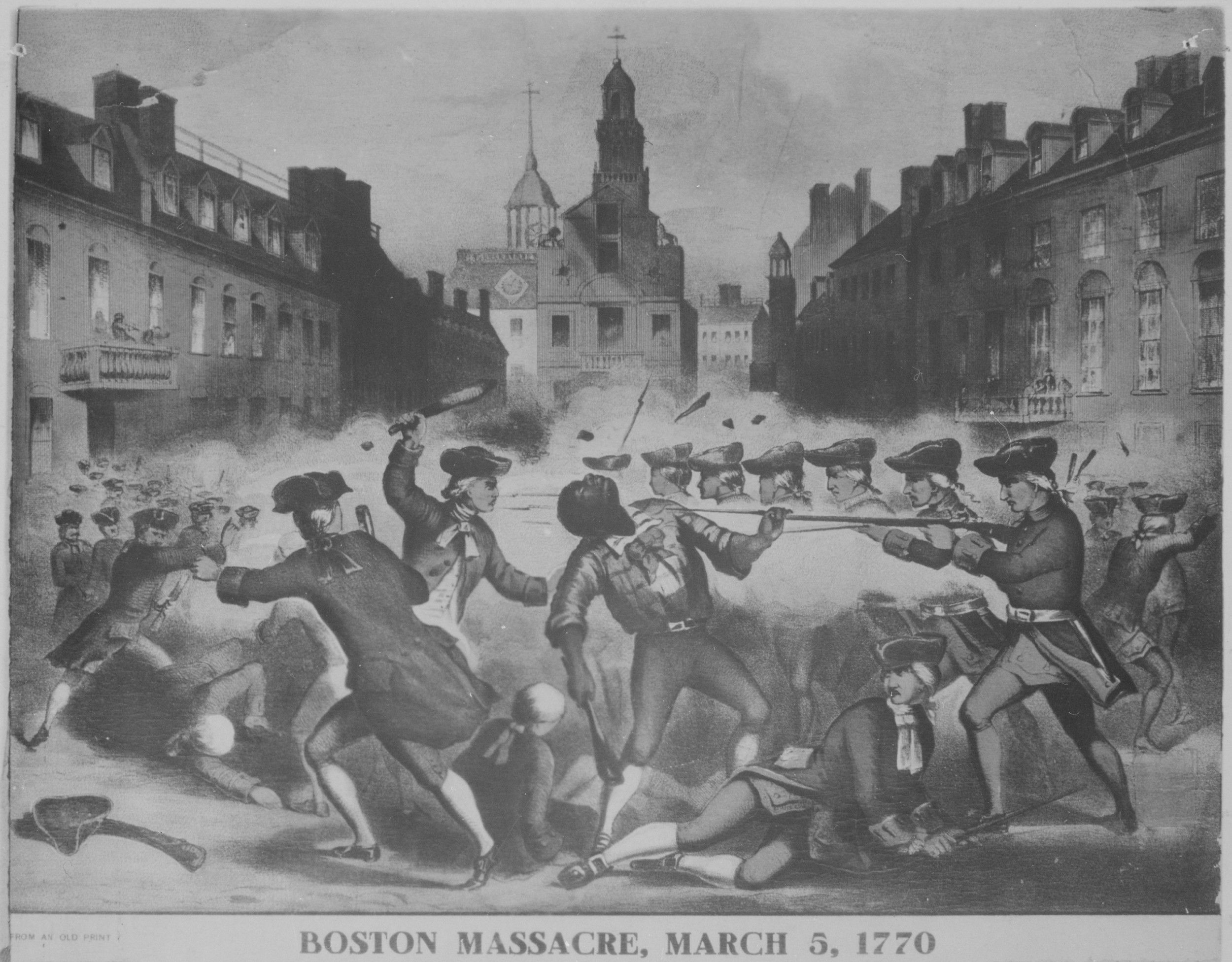
Document
The Destruction of Tea at Boston Harbor. 1773. Copy of lithograph by Sarony & Major, 1846
12/16/1773 (artwork 1846)
Famous illustrators Sarony & Major created this lithograph depicting the Boston Tea Party of 1773. It was gathered as part of the George Washington Bicentennial Commission. The Commission's purpose was to celebrate the birth and accomplishments of Washington, and to collect, preserve, and publish writings, artworks, and photographs pertinent to his life and times.
The National Archives holds this photograph (from 1931-1932) of the print as part of the records of the Commission.
The National Archives holds this photograph (from 1931-1932) of the print as part of the records of the Commission.
This primary source comes from the Records of Commissions of the Legislative Branch.
National Archives Identifier: 532892
Full Citation: Photograph 148-GW-439; The Destruction of Tea at Boston Harbor. 1773. Copy of lithograph by Sarony & Major, 1846; 12/16/1773 (artwork 1846); The George Washington Bicentennial Commission, 1931 - 1932; Records of Commissions of the Legislative Branch, ; National Archives at College Park, College Park, MD. [Online Version, https://docsteach.org/documents/document/boston-harbor, April 26, 2024]The Destruction of Tea at Boston Harbor. 1773. Copy of lithograph by Sarony & Major, 1846
Page 2
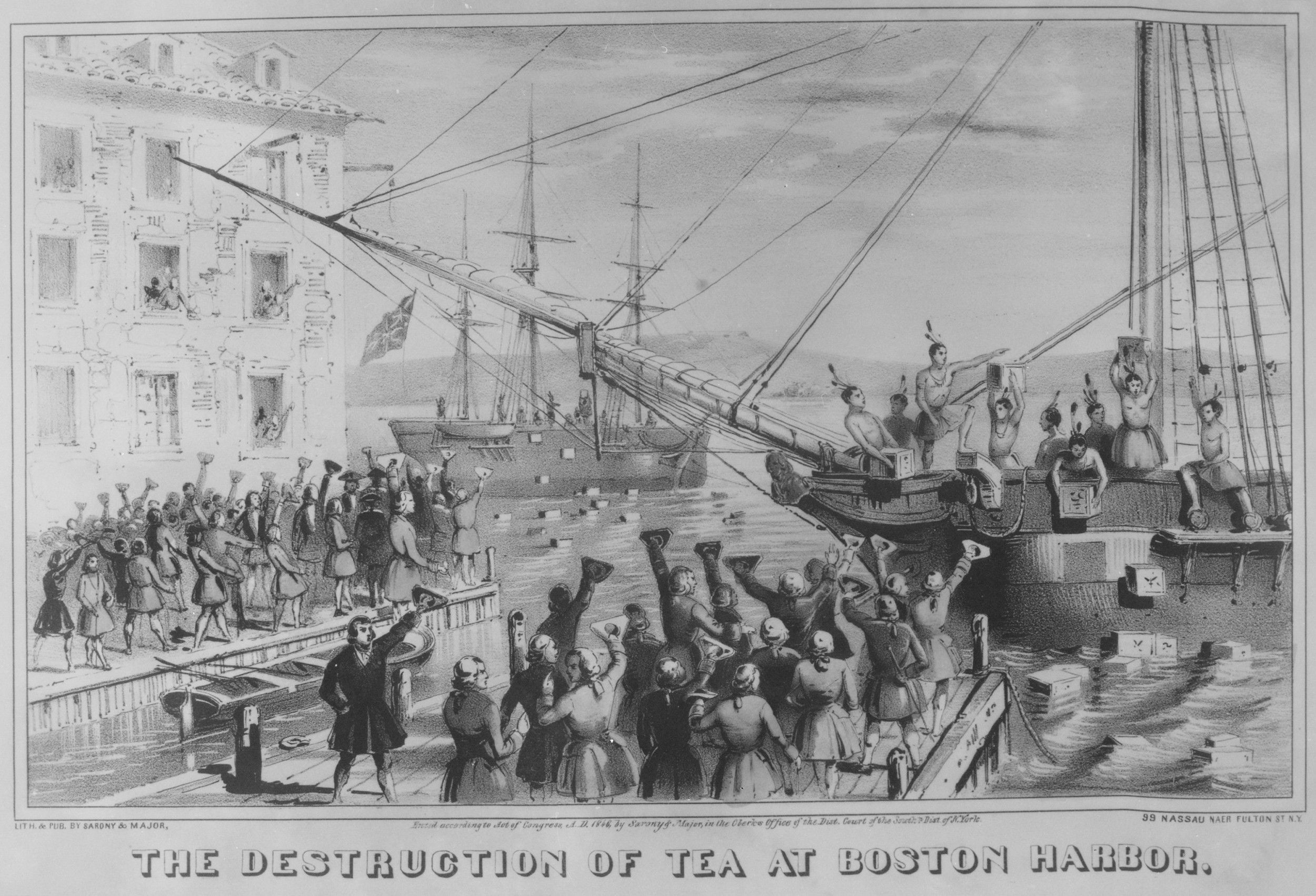
Document
Drafting the Declaration of Independence. The Committee - Franklin, Jefferson, Adams, Livingston and Sherman. Copy of engraving after Alonzo Chappel.
1776 (artwork 1857)
This is a copy of 1857 engraving by Alonzo Chappel. It shows the Committee of Five – Benjamin Franklin, Thomas Jefferson, John Adams, Robert Livingston, and Roger Sherman – drafting the Declaration of Independence during the Second Continental Congress in Philadelphia.
This primary source comes from the Records of the Bureau of Public Roads.
National Archives Identifier: 513332
Full Citation: Photograph 30-N-31(170); Drafting the Declaration of Independence. The Committee - Franklin, Jefferson, Adams, Livingston and Sherman. Copy of engraving after Alonzo Chappel.; 1776 (artwork 1857); Historical Photograph Files, 1896 - 1963; Records of the Bureau of Public Roads, ; National Archives at College Park, College Park, MD. [Online Version, https://docsteach.org/documents/document/drafting-declaration, April 26, 2024]Drafting the Declaration of Independence. The Committee - Franklin, Jefferson, Adams, Livingston and Sherman. Copy of engraving after Alonzo Chappel.
Page 1
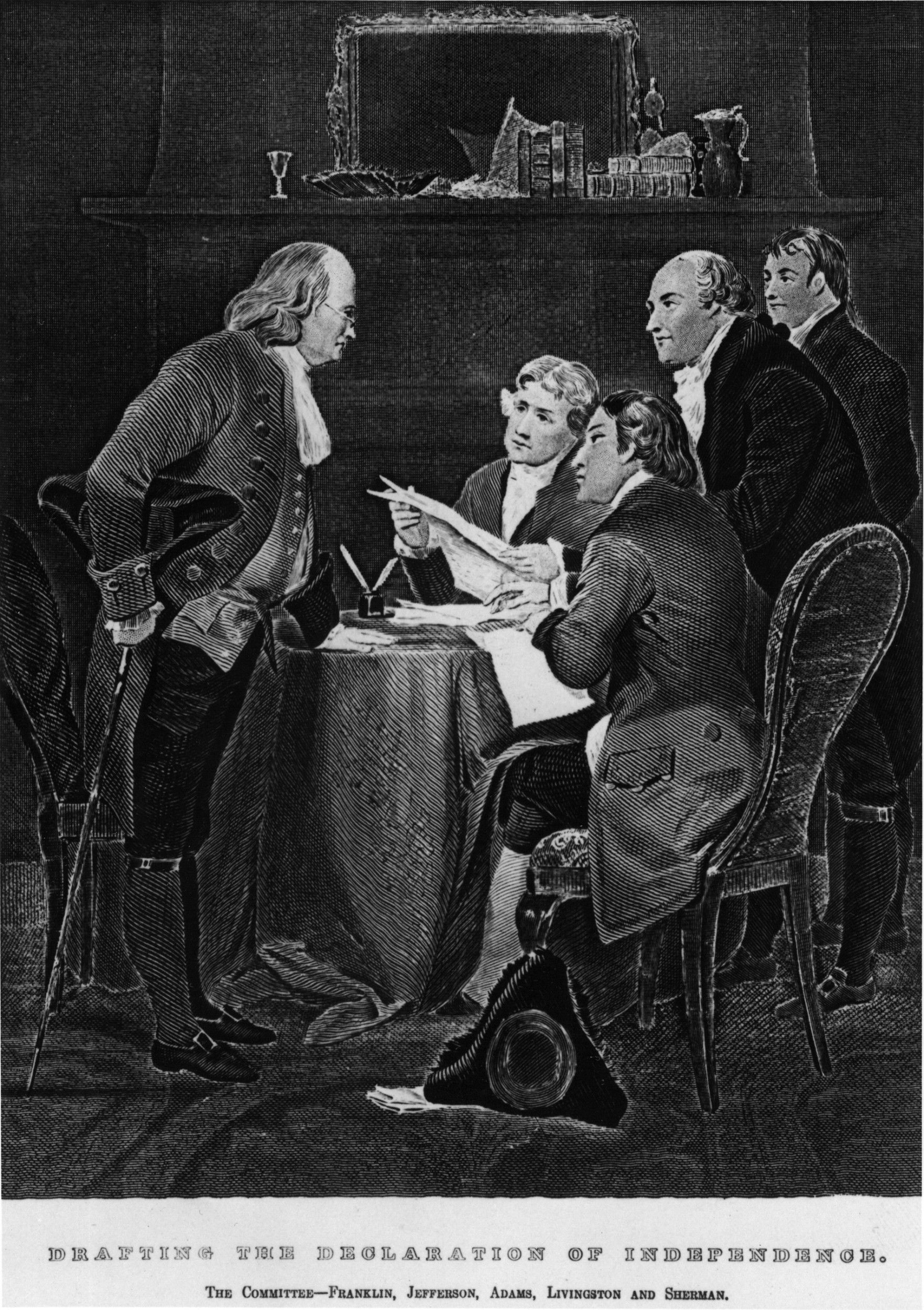
Document
Reading of the Declaration of Independence from the East balcony of the Old State House, Boston, Massachusetts July 18, 1776. Copy of artwork.,
7/18/1776
This is a copy of artwork showing the reading of the Declaration of Independence from the East balcony of the Old State House in Boston, Massachusetts. It was gathered as part of the George Washington Bicentennial Commission in 1931-1932. The Commission's purpose was to celebrate the birth and accomplishments of Washington, and to collect, preserve, and publish writings, artworks, and photographs pertinent to his life and times.
This primary source comes from the Records of Commissions of the Legislative Branch.
National Archives Identifier: 532942
Full Citation: Photograph 148-GW-1141; Reading of the Declaration of Independence from the East balcony of the Old State House, Boston, Massachusetts July 18, 1776. Copy of artwork.,; 7/18/1776; The George Washington Bicentennial Commission, 1931 - 1932; Records of Commissions of the Legislative Branch, ; National Archives at College Park, College Park, MD. [Online Version, https://docsteach.org/documents/document/reading-declaration-independence, April 26, 2024]Reading of the Declaration of Independence from the East balcony of the Old State House, Boston, Massachusetts July 18, 1776. Copy of artwork.,
Page 2
